![]()
![]()
![]()
Use LEFT and RIGHT arrow keys to navigate between flashcards;
Use UP and DOWN arrow keys to flip the card;
H to show hint;
A reads text to speech;
19 Cards in this Set
- Front
- Back

|
The Holy Trinity
Artist: Masaccio Year: 1420 Patron: Basillica Santa Maria Novella Location: Dominican church of Santa MariaNovella, Florence Above the skeleton is an inscription, which states, “As I am now, so you shall be. As you are now, so once was I”. The message is that death is inevitable. Masaccio, influenced by giotto, completely rejects the International Gothic style* Vasari describes Masaccio as absent minded and careless The center of fresco, we see the Holy Trinity and by Holy Trinity means the three part nature of God. At the top, it got the Father. Below, in the form of the dove, it has theHoly Spirit. Below the dove, it has Christ on the cross and it has the Father, the Son, and the Holy Spirit. The other figures in the sacred space with in the room that’s depicted are Mary, in the dark cloak. She’s presenting her son to people. She’s pointing up at Christ, showing us that Christ is the path to salvation. · And on the opposite side, it has Saint John. · On the outside of the scared space, in a prayerful position kneeling, looking in and witnessing as we’re looking in and witnessing, are the donors. |
|
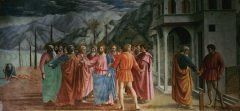
|
The tribute Money
Artist: Masaccio Year: 1430 Patron: Brancacci Chapel Location: Florence |
|
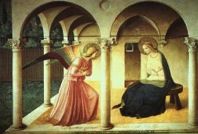
|
Annunciation
Artist: Angelico Year: 1440 Patron: Monastery of San Marco Location: Florence |
|
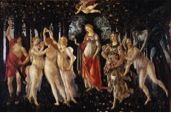
|
Primavera
Artist: Botticelli Year: 1480 Patron: Probably Medici |
|

|
Brunelleschi
Dome of Florence Cathedral Renaissance (Italian). |
|
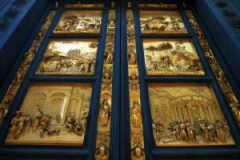
|
Ghiberti
Gates of Paradise Renaissance (Italian) |
|
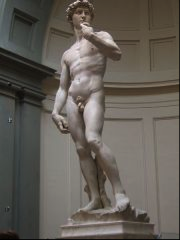
|
David
Artist: Michelangelo Year: 1500 period: High Renaissance Patron: Florence Cathedral Location: Florence Thefirst life-size male nude created since classical antiquity. |
|
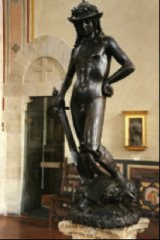
|
Donatello
was a sculptor who worked with stone,marble, bronze casting and poly-chromed wood. Donatello’sOther Artforms: also created relief sculptures and designed interiors Patron:Cosmo d’ Medici, according to most |
|
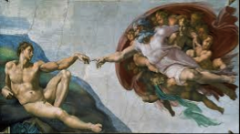
|
Creation of Adam
Artist: Michelangelo Year: 1510 Patron: Vatican Location: Sistine Chapel, Vatican City· Minhelangelo regarded this as the mostbeautiful body he ever created. |
|
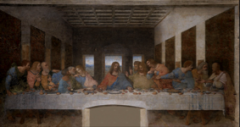
|
LastSupper
Artist: Da Vinci Year: 1500 Patron: Sforza, Duke of Milan Location: Renovation of church |
|
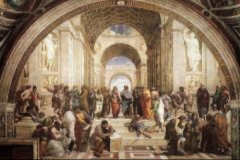
|
School of Athens
artist:Raphael period: High Renaissance date: 1509-1511 One of four frescoes painted by Raphel in theStanza della Segnatura,the Pope’s library, under a commission from Julius II. Each painting representsa different aspect of human endeavor: Theology, Law, Poetry and Philosophy. Inthis painting, Raphael divides the empirical philosophers (led by Aristotle)from the metaphysicists (led by Plato), including himself among those who favorevidence gathered through scientific and mathematical reasoning. The paintingis a fitting tribute to Pope Julius, whose qualities we might note include: • choice of a name meant to recall not saintsbut Julius Caesar – one of the greatest Roman commanders and the man whodeclared himself emperor • the art he commissioned was designed toreinforce the papal authority • his building projects & militarycampaigns were expensive, leading to the Reformatio |
|
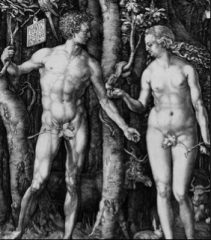
|
Northern Renaissance
DürerAdam and Eve 1504 |
|
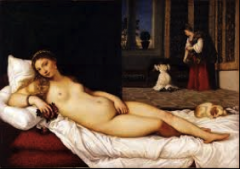
|
Titian
Venusof Urbino HighRenaissance, Italy |
|

|
Venus, Cupid, Folly &Time
artist: Bronzino period: Mannerism date: 1546 An allegorical discussion of the folly oflove, illustrating the saying: “in the end, time will uncover all.” Besidesnoting that the figures are allegorical – Venus, Cupid, Father Time, Envy,Deceit and Folly (with the rose petals), you should also note that they aretypical of mannerism: elongated limbs; emphasis on elegant feet and hands;smooth glowing skin; complexity of figures and distortion; no central focal point. |
|

|
Isenheim Altarpiece
artist: Grunewald period: Northern European Renaissance date: 1510-1515 This altarpiece was made for a hospital whichspecialized in skin diseases, especially Saint Anthony’s Fire – ergotpoisoning. The figure of Christ is painted as if he is suffering from such adisease – his skin is grey-green and full of lesions. The artist and hispatrons, the monks, felt that it would be beneficial for the dying patients togaze on Christ and recall that his suffering was on their behalf, and that theywill soon be released into eternal life where they will no longer suffer. |
|
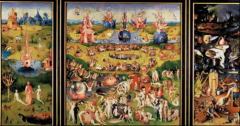
|
Artist of the Garden of Earthly
Delights:Hieronymus Bosch (1505 to 1515) Hisstyle was closer to medieval art than it was to Renaissance art; his figuresstylized for the most part. Mainly the subject of the triptych is sin. Anaristocrat, probably Count Hendrick III of Nassau, commissioned this for hisBrussels townhouse. Left Wing: Creation Central Panel: shows man enjoying various pleasures Right Wing: Hell Afterreading the article by Laurinda Dixon, it would be possible to apply analchemical interpretation to this painting. One could view the central paneland the exterior (closed) wings as an alchemic metaphor for human salvation. Manyof the structures in the “garden” are quite similar to vessels and distillationjars used in alchemy. Closed, the wings depict the third day of creation, orperhaps, given the translucence of the Earth as it is featured, one could viewit as a distillation vessel as well— the purpose of which may be to transformhuman flaws into spiritual perfection. |
|
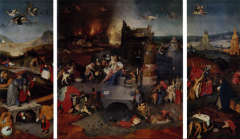
|
Hieronymus Bosch
Triptychof Saint Anthony ca. 1505-10 oil on panelPortrays the temptation of St. Anthony whowent into the desert and was tempted by various visions but holds on to hisfaith and Bible. Left wing has him is shown being carried by supporters butalso to heaven on a creature. Right shows temptations.
|
|
|
List four ways in which the role of theartist changed during the Renaissance.
|
· Change of subjects
· Realism · New Techniques and Styles · Perspective |
|
|
What are the dates for the High Renaissance?
|
igh Renaissance art, which flourished for about 35years, from the early 1490s to 1527, when Rome was sacked by imperial troops,revolved around three towering figures: Leonardo da Vinci (1452–1519), Michelangelo(1475–1564), and Raphael (1483–1520).
|

